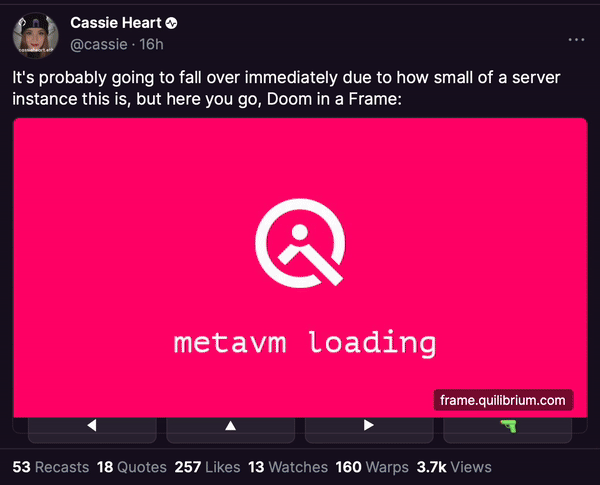
A Combinatorial Frame of Mind
Opengraph features can catalyze emergent complexity
First of all, the past few days have been incredible.
There's too many frames to list at the moment, but it's already clear that mini-apps in the social feed can be head-and-shoulders above the typical social media experience of consumption that is as addictingly passive as possible. All frames are games. There's a depth of inputs, and depending on the purpose & rules, there isn't really a limit on the amount of reward. Depending on the flexibility of the application, there isn't really a limit on the value that the user can send back to the developer. Let me briefly explain.
Site Abstraction is Account Abstraction
FIrstly, go check out Base Quest & Nethria. Two different RPGs in a Frame, one of which uses AI for randomization, but what's most important is that different teams are rapidly developing a class of widget where the user navigates, then interacts, with some comprehendible environment. Of course, some gigabrain decided to run the FPS, Doom, in a Frame. So with the right backend, any visual environment can fit within a Frame (as much as MJPEG can handle it).
More on that later. The immediate point is, there's a state & the user, through a EdDSA signer, can apply changes to that state.
One of the most popular frames, by jacopo.eth, has been a very seamless NFT mint, gated by social action (recasting) along with additional onchain qualifications.
There's other gated combinations, like a $degen-gated poll. Of course, there can be n gates, and at the end of the Frame, an output can be to another site or somewhere onchain, the costs abstracted away by the Frame developer. With up to four buttons, the design space is very wide.
One way to go is just nested menus. I think awesomelists on github should be upgraded to gated awesomeframes on Farcaster clients. Navigate through projects by a brief abstract, pick from a variety of resource like documentation, code repository, or anything more active. At the end, redirect to that site.

By why stop at navigating static sites? There's already ways to leverage that signer for onchain actions. Corbin.eth's Patch Wallet can be directly controllable onframe. Since it's possible to jump from one Frame to the next, a user could navigate through all protocols compatible with that given smart wallet, from that one location in the social feed.
But why stop at this much security? If a redirect -> create signer -> allow signer flow manifests in the coming days, there can be a lot of compartmentalization through modular abstraction primitives like ERC-7579, each cluster of functions having a respective signer. Spend slightly more gas upfront (or subsidize it for the users), and the following UX can be both smoother & secure.
Third-Party Interaction is Autonomous Abstraction
So we can play games like Doom & simple RPGs in a Frame. What's the big deal? Well, at some point builders don't need to give the users the direct controls.

What would it take to have operant conditioning in a frame? Take Pokemon, for example:
Imagine you start the game, allowing the RL agent to click buttons at random. It does something useful, click reward. Something worthless, click punishment (anger emoji). If the situation isn't recoverable, reset. If the situation is pretty good, but there's too many options, export a snapshot of that state to a new frame in replies. With the right gating prior to initialization, the social graph on Farcaster can invest reputable human feedback for any given agent, so long as the agent's behavior can be exhibited onframe. For any given snapshot of a gamestate, the most rewardable task or skill can be redefined and reselected directly from the replies in the social network. If you're developing something like rabbit's Large Action Model, just crowdsource feedback on task-learning directly from the Farcaster client feed. If you need to crowdsource the underlying LLM agent curricula (with an app like Autogen Studio), generate an OTP from the frame, and redirect to the curriculum-drafting interface:
Stacking Bountycaster should be pretty simple. This can even be used for an in-app points or a longtail "recast-chain" incentive (1/2^n, where n is the # of degrees of referral away from the main claimant of the incentive). The implication that Farcaster may have just become the best place on the internet for incubating autonomous agency cannot be overstated. The icing on the cake is that Farcaster Frames have integrated onchain rewards overnight (literally). Make of that what you will.
Multiplayer Signature is Governance Abstraction
We've already known this since multisigs like Gnosis Safe & voting platforms like Snapshot have popularized DAOs. Thing is, DAO execution has carried a lot of friction, and I for one have a lot of respect for all the contributors in the ecosystem that have worked through that friction. But things have just profoundly improved.
Even if there weren't recent developments like z0r0z's Dagon (an abstraction layer for making anything a group account), the account abstraction I described above would be just as relevant. DAOs seem to work best with delegation in both directions; from voting power & liquid capital bottom-up, to subdivision of labor and super-focused executive discipline top-down. It should be easy in the coming months to allocate capital to intermediate, organizational outcomes just by clicking a button on a social feed. It should be considerably more obvious that yield from DeFi can be shunted directly to public & private works, when interacting with both foci occurs in the same feed.
There's also a benefit to token-gating frames that reward users: the token can be a proof of funding and/or contribution. Any software startup can capitalize on primitives like hypercerts, which in turn can be issued for publicly funding the development & maintenance of the FOSS libraries in that startup's stack. Every startup should incentivize feedback by continuously broadcasting discounts & alpha features through survey frames. This feature isn't even a week old.
Honestly, I'm just trying to catch up on all the Frames being hacked together. It's been incredible to see all the work, especially all the quick implementations that have vindicated the Merkle team's decisions. But it's already abundantly clear that Farcaster Frames hasn't come close to saturating its potential.











https://arxiv.org/abs/2408.14837 cc @cassie almost time for "farcaster judges doom in a frame"
lfg
You wrote this?
no, just sharing it. but I did write https://paragraph.xyz/@m-j-r.eth/farcaster-frames which does point out that reputable feedback & checkpoints are possible via frames, leading to many kinds of improved agents.
Frames can be used to play games Seems some proofs of recent I believe we’re slowly knowing the full potential of frames
Finally, a way to play DOOM at 20 FPS, just like the good old days! Now with a neural model so realistic, even humans can barely tell it's lagging. 😂 #NextGenNostalgia